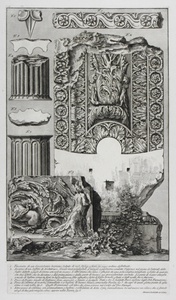| Method | Etching |
| Artist | Giovanni Battista Piranesi |
| Published | Piranesi Architetto dis. ed inc. [Rome, Bouchard, c.1753] |
| Dimensions | Image 395 x 258 mm, Plate 455 x 260 mm, Sheet 590 x 395 mm |
| Notes |
An illustration of various column pieces and architectural fragments, from Piranesi's Trofei di Ottaviano Augusto. The seven illustrations on the sheet show a fragment of a marble frieze with meandering floral design, a large soffit fragment featuring acanthus patterns and a central design of birds and branches, a relief fragment featuring a dryad and the hindquarters of a panther or lion in a curling acanthus pattern, two fragmentary pillars with diagrams of their cross sections and fluting, and a small architectural fragment of an egg and dart pattern. Piranesi's first foray into archaeological survey was the short, but grandiosely titled, volume Trofei di Ottaviano Augusto innalzati per la Vittoria ad Actium e conquista dell'Egitto con vari altri ornamenti diligentemente ricavati dagli avanzi piu preziosi delle fabbriche antiche di Roma, utili a pittori, scultori ed architetti, designati ed incisi da Giambattista Piranesi, Architetto Veneziano. Taking as its inspiration the two antique trophies that had been set up on the terrace of the Campidoglio in 1590, Piranesi argued for an attribution to Augustus in commemoration of the Battle of Actium. The trophies, which had been rediscovered in an excavation of the fountainhead of the Aqua Julia, were colloquially known as the Trophies of Marius. Piranesi's pamplet contained detailed illustrations of the trophies, as well as a pair of general views and a series of plates depicting other architectural fragments that the artist believed would be of interests to other antiquarians, sculptors, architects, and cognoscenti. Giovanni Battista (also Giambattista) Piranesi (1720 – 1778) was an Italian artist famous for his etchings of Rome and of fictitious and atmospheric "prisons" (the Carceri d'Invenzione). He was a major Italian printmaker, architect and antiquarian. The son of a Venetian master builder, he studied architecture and stage design, through which he became familiar with Illusionism. During the 1740's, when Rome was emerging as the centre of Neoclassicism, Piranesi began his lifelong obsession with the city's architecture. He was taught to etch by Giuseppe Vasi and this became the medium for which he was best known. Wilton-Ely 277, F142, C388b Condition: Strong clean impression. Minor time toning to edges of sheet. |
| Framing | unmounted |
| Price | £600.00 |
| Stock ID | 50558 |

